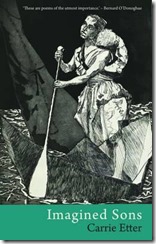Book Review – Imagined Sons by Carrie Etter
 I can’t remember how I was put on to Carrie Etter’s latest work, Imagined Sons. My taste in poetry runs more towards form and free verse with a distinct focus on sound and rhythm. That being said I found Imagined Sons as a whole product/project a powerful work. In this, Etter’s seventh collection she presents 38 poetically crafted scenarios similar to the one below.
I can’t remember how I was put on to Carrie Etter’s latest work, Imagined Sons. My taste in poetry runs more towards form and free verse with a distinct focus on sound and rhythm. That being said I found Imagined Sons as a whole product/project a powerful work. In this, Etter’s seventh collection she presents 38 poetically crafted scenarios similar to the one below.
Imagined Sons 4: Black and Velvet
I see a group of teenage goths outside Fopp, and one girl’s mélange of black chiffon and crimson velvet reminds me of a previous self. I look at the boy she leans against, with studs in his nose, eyebrow and chin, and silver, inch-wide hoops inside his lobes, and I look away, feeling queasy.
But as I turn, our eyes meet, and his flashing glare says he saw an unintended look of revulsion. And it occurs to me, as I head into the shop, that he is about my height, that he has my large, dark eyes, and that to glance back would evoke a sneer.
I remember The Sisters of Mercy, a band I listened to in those black and velvet days, and start browsing my way toward them from the beginning of the alphabet, thinking to avoid him, thinking to meet.
These don’t refer to the same son, but rather possible sons. Sometimes these ponderings, these fantasies of “what could have been”, seem a torture. Sometimes there are happy endings. Some of the poems could standalone and others are multipart and spread throughout the collection:
Imagined Sons 11: The Friend (Part 1)
At the park, I find the bench and watch families, couples and solitary dog-walkers stroll by. After a while, a young man, tall and thin with wispy blonde hair, sits down at the other end of the bench.
‘You’re not him,’ I say, suppressing a sigh.
‘No, but I’m his friend. I’ve come to take you to him.’
I jump to my feet, and he rises to my side.
After a few minutes, I ask, ‘Is he close?,’ walking so quickly I nearly run.
‘Yes, just ahead,’ he replies, not meeting my gaze.
We pass through a stand of trees, sunlight sprinkling the path as the canopy of leaves shifts, rustling, with breezes. Coming out on the other side, I’m surprised to see no people, no one visible in the distance, only low stones, tablets of grey and black, occasionally a white cross, and I apprehend that this is a –
At the park, I find the bench and watch families, couples and solitary dog-walkers stroll by. After a while, a young man, tall and thin with wispy blonde hair, sits down at the other end of the bench.
‘You’re not him,’ I say, suppressing a sigh.
‘No, but I’m his friend. I’ve come to take you to him.’
I jump to my feet, and he rises to my side.
After a few minutes, I ask, ‘Is he close?,’ walking so quickly I nearly run.
‘Yes, just ahead,’ he replies, not meeting my gaze.
We pass through a stand of trees, sunlight sprinkling the path as the canopy of leaves shifts, rustling, with breezes. Coming out on the other side, I’m surprised to see no people, no one visible in the distance, only low stones, tablets of grey and black, occasionally a white cross, and I apprehend that this is a –
To break what is in essence a multiplicity of poetic narratives is a presentation of the Birth Mother’s Catechism every 5 or so poems. I love the religious overtone this device implies and the repetition of the questions simultaneously gives the reader a break from the prose while giving an insight into the mother’s state of mind, into the questions many birthmothers must ask themselves. Here is the first which occurs before the first prose poem:
A Birthmother’s Catechism
How did you let him go?
With black ink and legalese
How did you let him go?
It’d be another year before I could vote
How did you let him go?
With altruism, tears and self-loathing
How did you let him go?
A nurse brought pills for drying up breast milk
How did you let him go?
Who hangs a birdhouse from a sapling?
Despite the work being structured around what is a serious and highly emotive subject/reality I think Etter has managed to be subtly balanced in the construction. The gamut of emotions are explored and I never felt I was drowning in sorrow. I did wonder what it might have been like to come to the works in individual form. My understanding is that some, if not most were previously printed in poetry journals and I’m not sure if the impact would be the same if the they were not read closely together. I felt that Imagined Sons benefited from being read as a complete collection of poems.
Imagined Sons, as I said, wasn’t necessarily within my usual preferences for poetry, but I do feel that the narratives do continue to work on me after I have closed the covers. Readers of short fiction as well as poetry would certainly enjoy her work too.
This review was based an a copy obtained from the South Australian Library Service.
Comments
Post a Comment